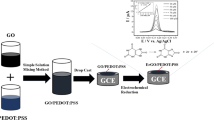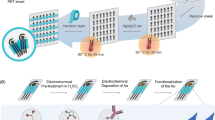Abstract
An ultrasensitive electrochemical glucose biosensor has been developed by depositing C60-fullerene functionalized with tetraoctylammonium bromide (C60-TOAB+) on the surface of a glassy carbon electrode (GCE). The glucose-binding protein concanavalin A (Con A) was then linked to the surface. Binding of glucose by Con A affects the electroactivity of the reversible redox couple C60/C60 −, and this finding forms the basis for a quantitative glucose assay over the 10 to 10 mM concentration range and with a lower detection limit of 3.3 nM (at an S/N ratio of 3). The sensitivity of this sensor allowed glucose to be determined in saliva. This biosensor possesses excellent selectivity, outstanding reproducibility and good long-term stability.

An ultrasensitive electrochemical glucose biosensor has been developed by depositing C60-fullerene functionalized with tetraoctylammonium bromide (C60-TOAB+) on the surface of a glassy carbon electrode (GCE). The glucose-binding protein concanavalin A (Con A) was then linked to the surface. Binding of glucose by Con A affects the electroactivity of the reversible redox couple C60/C60 −, and this finding forms the basis for a quantitative glucose assay over the 10 to 10 mM concentration range and with a lower detection limit of 3.3 nM (at an S/N ratio of 3). The sensitivity of this sensor allowed glucose to be determined in saliva.






Similar content being viewed by others
References
Zhang L, Ni YH, Li H (2010) Addition of porous cuprous oxide to a Nafion film strongly improves the performance of a nonenzymatic glucose sensor. Microchim Acta 171:103–108
Chen C, Xie QJ, Yang DW, Xiao HL, Fu YY, Tan YM, Yao SZ (2013) Recent advances in electrochemical glucose biosensors: a review. RSC Adv 3:4473–4491
Ronkainen NJ, Halsall HB, Heineman WR (2010) Electrochemical biosensors. Chem Soc Rev 39:1747–1763
Wang JP, Thomas DF, Chen AC (2008) Nonenzymatic electrochemical glucose sensor based on nanoporous PtPb networks. Anal Chem 80:997–1004
Wang J (2008) Electrochemical glucose biosensors. Chem Rev 108:814–825
Lim SH, Wei J, Lin JY, Li QT, You JK (2005) A glucose biosensor based on electrodeposition of palladium nanoparticles and glucose oxidase onto nafion-solubilized carbon nanotube electrode. Biosens Bioelectron 20:2341–2346
Cetik S, Zhang Y, Hupkens E, Jurysta C, Malaisse WJ, Sener A (2013) A tentative model for D-glucose turnover in human saliva. Oral Biol 58:1265–1270
Ye DX, Liang GH, Li HX, Luo J, Zhang S, Chen H, Kong JL (2013) A novel nonenzymatic sensor based on CuO nanoneedle/graphene/carbon nanofiber modified electrode for probing glucose in saliva. Talanta 116:223–230
Rowe L, Deo S, Shofner J, Ensor M, Daunert S (2007) Aequorin-based homogeneous cortisol immunoassay for analysis of saliva samples. Bioconjug Chem 18:1772–1777
Chen X, Wu G, Cai Z, Oyama M, Chen X (2014) Advances in enzyme-free electrochemical sensors for hydrogen peroxide, glucose, and uric acid. Microchim Acta 181:689–705
Steiner MS, Duerkop A, Wolfbeis OS (2011) Optical methods for sensing glucose. Chem Soc Rev 40:4805–4839
Becker JW, Reeke GN, Cunningham BA, Edelman GM (1976) New evidence on the location of the saccharide-binding site of concanavalin A. Nature 259:406–409
Liu SQ, Wang KW, Du D, Sun YM, He L (2007) Recognition of glycoprotein peroxidase via Con A-carrying self-assembly layer on Gold. Biomacromolecules 8:2142–2148
Dam TK, Brewer CF (2002) Thermodynamic studies of lectin-carbohydrate interactions by isothermal titration calorimetry. Chem Rev 102:387–429
Hu FX, Chen SH, Wang CC, Yuan R, Xiang Y, Wang C (2012) Multi-wall carbon nanotube-polyaniline biosensor based on lectin-carbohydrate affinity for ultrasensitive detection of Con A. Biosens Bioelectron 34:202–207
Scida K, Stege PW, Haby G, Messina GA, García CD (2011) Recent applications of carbon-based nanomaterials in analytical chemistry: Critical review. Anal Chim Acta 691:6–17
Kroto HW, Heath JR, O Brien SC, Curl RF, Smalley RE (1985) C60: buckminsterfullerene. Nature 318:162–162
Kratschmer W, Lamb LD, Fostiropoulos K, Huffman DR (1990) Solid C60: a new form of carbon. Nature 347:354–354
Ye C, Zhong X, Yuan R, Chai YQ (2014) A novel ECL biosensor based on C60 embedded in tetraoctylammonium bromide for the determination of glucose. Sens Actuators B: Chem 199:101–107
Qian L, Yang XR (2007) Effective enhancement of peroxydisulfate electrochemiluminescence on C60/DDAB films. Electrochem Commun 9:393–397
Jehoulet C, Bard AJ (1991) Electrochemical reduction and oxidation of C60 films. J Am Chem Soc 113:5456–5457
Chlistunoff J, Cliffel D, Bard AJ (1995) Electrochemistry of fullerene films. Thin Solid Films 257:166–184
Nakashima N, Tokunaga T, Nonaka Y, Nakanishi T, Murakami H, Sagara T (1998) A fullerene/lipid electrode device: reversible electron transfer reaction of C60 embedded in a cast film of an artificial ammonium lipid on an electrode in aqueous solution. Angew Chem Int Ed 37:2671–2673
Nakashima N, Ishii T, Shirakusa M, Nakanishi T, Murakami H, Sagara T (2001) Molecular bilayer-based superstructures of a fullerene-carrying ammonium amphiphile: structure and electrochemistry. Chem Eur J 7:1766–1772
Nakanishi T, Morita M, Murakami H, Sagara T, Nakashima N (2002) Structure and electrochemistry of self-organized fullerene-lipid bilayer films. Chem Eur J 8:1641–1648
Li GB, Han Z, Piao GZ, Zhao J, Li SX, Liu GY (2009) To distinguish fullerene C60 nanotubes and C60 nanowhiskers using Raman spectroscopy. Mater Sci Eng B 163:161–164
Hsieh SN, Hsiao SW, Chen TY, Li CY, Lee CH, Guo TF, Hsu YJ, Lin TL, Wei Y, Wen TW (2011) Self-assembled tetraoctylammonium bromide as an electron-injection layer for cathode-independent high-efficiency polymer light-emitting diodes. J Mater Chem 21:8715–8720
Calvaresi M, Zerbetto F (2010) Baiting proteins with C60. ACS Nano 4:2283–2299
Guldi DM (2002) Fullerene-porphyrin architectures; photosynthetic antenna and reaction center models. Chem Soc Rev 31:22–36
Zhong X, Yuan R, Chai YQ (2012) In situ spontaneous reduction synthesis of spherical Pd@Cys-C60 nanoparticles and its application in nonenzymatic glucose biosensors. Chem Commun 48:597–599
Imahori H, Tamaki K, Araki Y, Sekiguchi Y, Ito O, Sakata Y, Fukuzumi S (2002) Stepwise charge separation and charge recombination in ferrocene-meso, meso-linked porphyrin dimer-fullerene triad. J Am Chem Soc 124:5165–5174
Valcárcel M, Cárdenas S, Simonet BM (2007) Role of carbon nanotubes in analytical science. Anal Chem 79:4788–4797
Chen D, Feng HB, Li JH (2012) Graphene oxide: preparation, functionalization, and electrochemical applications. Chem Rev 112:6027–6053
Ambrosi A, Chua CK, Bonanni A, Pumera M (2014) Electrochemistry of graphene and related materials. Chem Rev 114:7150–7188
Ballerstadt R, Kholodnykh A, Evans C, Boretsky A, Motamedi M, Gowda A, McNichols R (2007) Affinity-based turbidity sensor for glucose monitoring by optical coherence tomography: toward the development of an implantable sensor. Anal Chem 79:6965–6974
Xu X, Jiang N, Hu Z, Liu SQ (2010) Nitrogen-doped carbon nanotubes: high electrocatalytic activity toward the oxidation of hydrogen peroxide and Its application for biosensing. ACS Nano 4:4292–4298
Liu S, Tian JQ, Wang L, Qin XY, Zhang YW, Luo YL (2012) A simple route for preparation of highly stable CuO nanoparticles for nonenzymatic glucose detection. Catal Sci Technol 2:813–817
Zhang D, Zhang K, Yao YL, Xia XH, Chen HY (2004) Multilayer assembly of prussian blue nanoclusters and enzyme-immobilized poly (toluidine blue) films and its application in glucose biosensor construction. Langmuir 20:7303–7307
Qiang LL, Vaddiraju S, Patel D, Papadimitrakopoulos F (2011) Edge-plane microwire electrodes for highly sensitive H2O2 and glucose detection. Biosens Bioelectron 26:3755–3760
Fu YC, Li PH, Xie QJ, Xu XH, Lei LH, Chen C, Zou C, Deng WF, Yao SZ (2009) One-Pot preparation of polymer-enzyme-metallic nanoparticle composite films for high-performance biosensing of glucose and galactose. Adv Funct Mater 19:1784–1791
Jia X, Hu GZ, Nitze F, Barzegar HR, Sharifi T, Tai CW, Wagberg T (2013) Synthesis of palladium/helical carbon nanofiber hybrid nanostructures and their application for hydrogen peroxide and glucose detection. Appl Mater Inter 5:12017–12022
Pleitez MA, Lieblein T, Bauer A, Hertzberg O (2013) In vivo noninvasive monitoring of glucose concentration in human epidermis by mid-infrared pulsed photoacoustic spectroscopy. Anal Chem 85:1013–1020
Acknowledgments
This work was financially supported by the NNSF of China (21075100, 21275119, 21105081), Ministry of Education of China (Project 708073), Research Fund for the Doctoral Program of Higher Education (RFDP) (20110182120010), Natural Science Foundation of Chongqing City (CSTC-2009BA1003, CSTC-2011BA7003, CSTC-2010BB4121), State Key Laboratory of Silkworm Genome Biology (sklsgb2013012), the Fundamental Research Funds for the Central Universities (XDJK2013A008, XDJK2013A27, XDJK2013C115), and specialized research fund for the doctoral program of higher education (swu113029) and (20100182110015) China.
Author information
Authors and Affiliations
Corresponding authors
Electronic supplementary material
Below is the link to the electronic supplementary material.
ESM 1
(DOC 463 kb)
Rights and permissions
About this article
Cite this article
Ye, C., Zhong, X., Chai, Y. et al. Sensing glucose based on its affinity for concanavalin A on a glassy carbon electrode modified with a C60 fullerene nanocomposite. Microchim Acta 182, 2215–2221 (2015). https://doi.org/10.1007/s00604-015-1559-8
Received:
Accepted:
Published:
Issue Date:
DOI: https://doi.org/10.1007/s00604-015-1559-8




